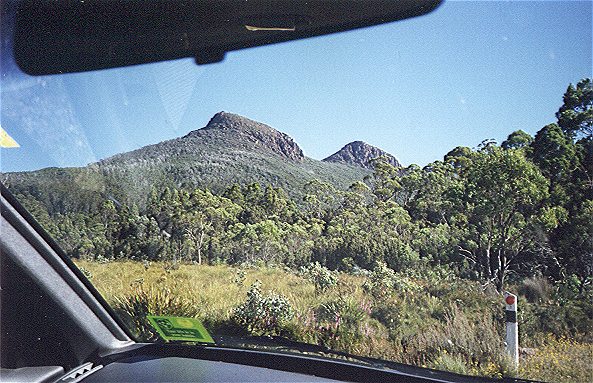
On Monday I go back to work. I felt like I'd wasted most of the summer: mostly I wasn't feeling well enough to get out and do all the bushwalking I'd planned. I was determined I was going to get out and take in some of the natural beauty of my state, before I ran out of free time, so in the last three free days this summer I hit the road and went places. And being me, I can't seem to help writing about it. So here is a brief interlude to my American travel journal: three days of Tasmanian summer.
It wasn't until the car was parked in the driveway with the engine running that I actually decided where to go. I thought we'd start with the West coast. I hadn't been there since 1982, when a girlfriend and I up and drove there on an impulse, and slept the night at Ocean Beach at Strahan. So we set off: me, Dog, Puppy, and Jessica (you remember the big new plushky I mentioned a few months ago? She has a name now...)
Weather was perfect; stayed up in the 80's the whole trip. The early hours of the first day took us through the lush Derwent Valley, renowned for its hops industry. Rolling hills, rich agricultural land; an Antipodean version of rural England, but gradually morphing into the dramatic, dark forests of the South West wilderness national park...

...(lots of potential wilderness walks passed up because of time limits :( ), and finally the brutal, Wagnerian mountainscapes of the West coast.
Tasmania's West is rugged, remote, dramatic; given to atrocious westerly gales, and notorious pockets of redneckism. Below Strahan - around halfway down the coast - there is no human habitation. When I was at Bathurst Harbour last August, the entire population of that 1/4 of the state was 2 people - a couple running a tin mine lease at Melalauca. The population of the west coast consists almost solely of a series of small mining towns separated by jagged peaks carved by glaciation in the last ice age. Astonishing mountains like Frenchman's Cap are constantly visible from the narrow, twisting highway, except when it plunges into cataracts of dark rainforest.
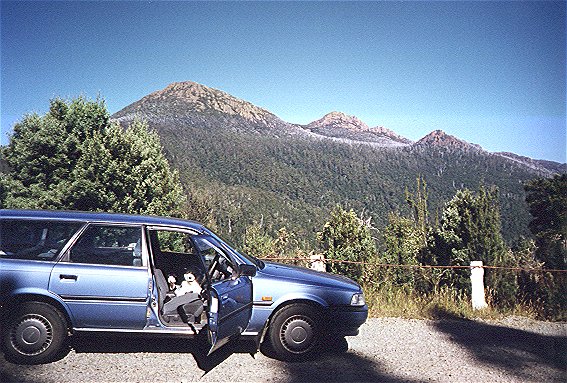
The first western town reached is Queenstown. The hills around this isolated community are a surreal Martian landscape. Fumes from the copper smelters killed the trees early this century, and now, as eco-tourism gradually replaces mining (doubtless to the ambivalence of the locals, whose anti-green sentiments during the Franklin River blockade were largely responsible for the red-neck reputation I alluded to) the shrubs are coming back, so the place has a stark, knuckled, measled appearance, which reminds me of the Mojave desert, except that, incongruously, an occasional manfern stands in stead of the Joshua Tree.
The other towns of the area are Strahan (the exception - a fishing village), Zeehan, Roseberry, and the even smaller and famously roughneck Savage River and Tullah. It was at this latter, where some ancestor apparently once ran the general store, that I stopped for the night. I hadn't really meant to, but I was short of petrol and it was 120 km's to the next sizeable settlement (which would be shut when I got there anyway.)
I wouldn't particularly recommend the 'lakeside chalet' or whatever they called it. The town is rough as guts, and this place (the classiest looking joint in town) was about the same. I had to procure a new light bulb, then prize the smashed remains of the previous one out of the lamp (and remove the clock/radio, as there was only one power socket and no double-adapter), then get into the cupboard that held the hot water cylinder so I could fix the toilet to stop it dribbling all night - but to be honest, a Hilton in Tullah would be out of place if not downright abominable, so no complaints really.
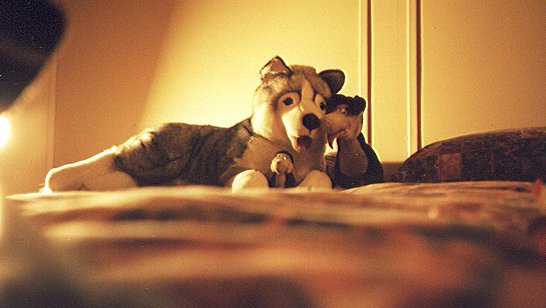
There'd been big bushfires in Tullah that day, and the motel was full of fire-fighters who'd been brought in from wherever. I shared the dining room with them. One bloke ordered something which, it turned out, wasn�t on the menu. Despite having this pointed out to him several times, he obstinately repeated "Marinated T-Bone" over and over. Around this time the chef's brandy pudding burst into flames, which caused immediate excitement amongst the fire-fighters. As there seemed to be some confusion as to the location of the rest-rooms they decided to nominate a tree outside the back door (in full view through the un-curtained windows, if anyone cared to look) as the designated pissing-spot for the evening. You might think this is just unsophisticated hickism, but as someone who enjoys pissing outdoors whenever possible, I don't find it unduly offensive.
Morning made Tullah worthwhile. The landscape fairly explodes around the town: great, towering, black-grey and jagged peaks, humming with dark, brooding power, presiding over dark, still and beautiful lakes.

On this second day I decided to head for the less gothic, friendlier vistas of the East coast, detouring first via Cradle Mountain. Here I picked up a German cyclist (don�t ask me why, but whenever I pick up a hitchhiker they invariably prove to be German). He had to go in the back seat, as Jessica occupied the whole passenger's side, and then some. My new companion said "He's a nice dog", as he leaned over to stroke her.
Manfred had just cycled from Arthur River - an ascent of 2500' , so I was amazed that, when I took him on an incredibly modest walk to Suicide Rock, overlooking Dove Lake, he began puffing and panting like an invalid. He explained that very fit cyclists can be very poor walkers, and hardened bushwalkers can be all at sea on bikes, so to speak.
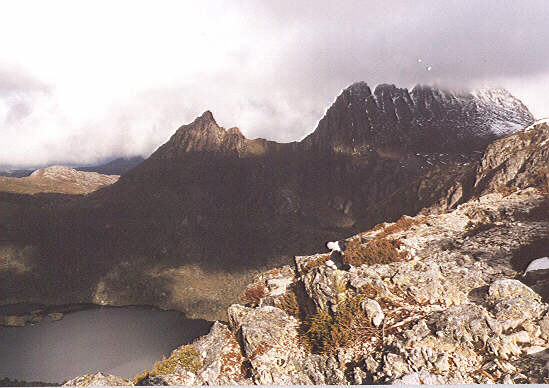
It was misty and cloudy, and the upper half of Cradle Mountain wasn't visible, which was a great shame from his POV. I admitted to being partial to moody, cold and harsh weather, at least in places such as Cradle Valley, where it accentuates the natural grandeur of the landscape. Based on this, and his assessment of my general personality, he recommended Ireland as my ideal destination, and as he runs a tourist business in Hamburg, gave me his card. He said I would have to practice drinking more, though - which puts him in agreement with my doctor, at least.
Manfred is thinking of emigrating to Tasmania, which ought to be relatively easy, as he has half a million dollars, several technical /scientific degrees, and wants to start a business. He said "In Germany we have a rule - all bosses are arseholes. Everyone wants to be a... what is the word... a King. His word is law." In Australia, and Tasmania in particular, he told me, bosses are more like co-ordinators, and simply work as part of the team. The work may be hard, but Australians work together, and don't make hard work of it, so he said. This seems to be a large part of his reason for wanting to 'escape' (his words) from Germany. Ireland had been his initial destination, but real estate prices went through the roof apparently. And besides, the Irish have an intolerable attitude towards fixing cars and bicycles ("It's making a noise? Well just drive it till something breaks, then we'll fix it.") I didn't tell him that this is my basic attitude to cars, too.
I left him and headed East to Sheffield, stopping at a five-house town called Claude Road, where there are a couple of Draught horses I befriended last July. They were pleased to see me, and it was hard to leave them again.
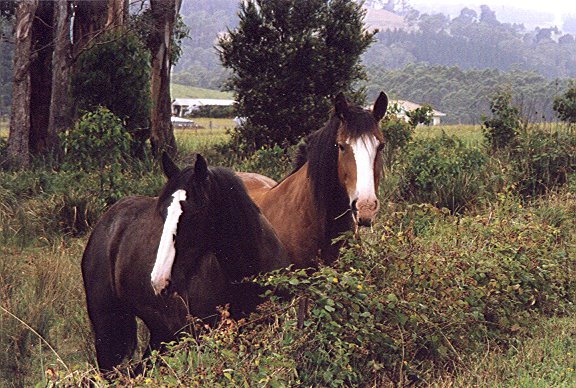
The land Northeast through the mountain passes around Scottsdale and Derby was, as always, stunningly beautiful. Rich farmland with soil the colour of congealed blood gave way to dense myrtle forests and towering tree-ferns. The north-east of Tasmania boasts some noteworthy Hotels. For instance, at Weldborough, the local drinking-hole has the semi-official designation of 'Worst hotel in the world.' When I was there in the 80's the menu boasted such delicacies as 'Blow-fly patties.' A plain sign affixed to the West side of the white weatherboard structure recognises this reputation with the simple declaration "Worst hotel." Further on I took a detour through the gorgeous farming country around Pynegana, home of the (allegedly) world-famous 'Pub in the Paddock.' My parents came here in the 50's on what was apparently the first tourist coach into the area. Max tells me the owner served them beer from a tea-kettle. The Pub in the Paddock (it's set back about two hundred yards from the road, in the middle of a field) has risen to take advantage of the nearby St Columba falls tourist drawcard, and now boasts its own attraction. A blackboard on the roadside reads, 'BEER DRINKING PIG'
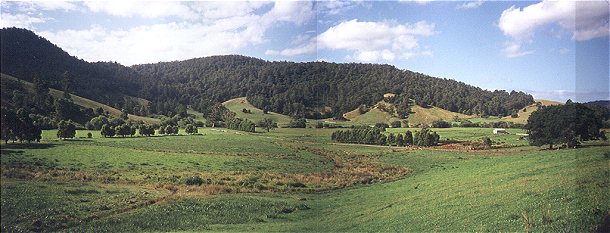
Max told me the bus driver couldn't find the falls on that first trip, but the route is signposted nowadays. It took a while to get there, as a herd of a couple of hundred cows were lumbering up the unsealed road. I was stared down briefly by a gigantic bull. He eventually lumbered by, at which time it was impossible not to observe the pair of colossal bollocks which passed by the window at eye-level. I wondered whether, should the tourist potential of the area grow, propriety might require the farmer to outfit this animal with a pair of undergarments of some sort, to protect the impressionable from possible corruption.

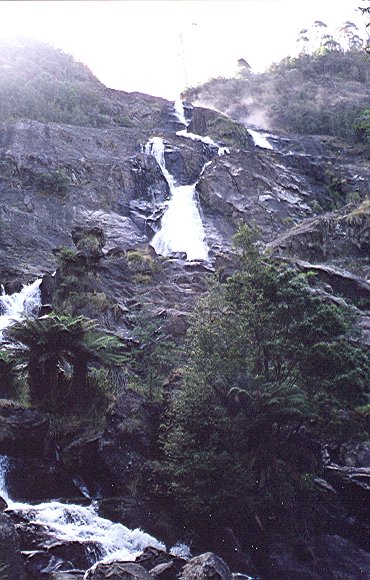 It looks much better than this really; take my word for it. I should have stopped at Montezuma Falls, which are 3 times as high. |
I wasn't really expecting anything spectacular, but the waterfall was utterly spectacular: a short walk through magnificent temperate rainforest brought me and Puppy to a 300' precipice which sent (according to the sign) up to 200,000 litres of water per minute crashing onto the rocks before the viewing platform. You should definitely visit St Columba falls if you come here. I'll take you, if you like. |
We continued on to St Helens, on the northern part of the East coast, and spent the last two nights of our little trip there. The East coast is characterised by unspoiled, and often deserted white beaches, bright blue waters, warm sunny weather (the absolute opposite of the west coast in almost every respect), and spectacular coastal outcroppings of quartz and red and grey granite. From jagged, windswept dark mountains, to dense rainforest, to South-pacific beaches, all in a day's drive. Tasmania. We found a place renting self-contained units on a hilltop overlooking St Helen's harbour (according to my travel agent yesterday, her 'favourite place on earth.") Two huge double bedrooms, fridge, oven, microwave, washing machine, yard, wild blackberries growing over the fence from the paddock next door, and at only $60 per night, in peak tourist season, it turned out to be about the most expensive joint in town. I was stoked.
St Helens is locally famous for its Pelicans, but they seemed to have gone on vacation elsewhere, or maybe were out on a fishing trip. There was, however, a wonderful variety of birdlife of other sorts. The trees around my cabin were constantly filled with flocks of New Holland Honeyeaters and Wattle Birds. These are quite common down where I live, but I'm not used to them flocking around my house in such large numbers. Their calls range from the unmistakable "Lookie-lookie-look!", to a more guttural sound usually described in wildlife books as "like someone vomiting." As I walked around the waterfront I also saw a pair of Galahs (a type of parrot normally seen in footage of the outback, where they congregate around waterholes in enormous flocks.) They're a beautiful bird, and a relatively unusual sight in Tasmania (near Bushy Park a few months ago I came across Sulphur Crested Cockatoos a few times (that's Barretta's bird), whose cry is one of the most awful things you can hear in the bush: it sounds like someone being murdered. There were lots of plain old seagulls around the waterfront of course, flying about screeching their heads off. It occurred to me on watching them wheeling around in the sunset that Seagulls are of such a temperament and personality that they really don�t _communicate,_ they just yell for the sake of yelling. Out in the bush, if you go quietly and concentrate on the sounds around you, you'll often pick up on the patterns of communication of the birds in the vicinity. I have often stopped to listen to a Mopoke owl hooting to his partner, somewhere invisibly across the mountain, and the same is true of all sorts of species. Seagulls just constantly squawk at nothing in particular, in a monologue which I like to think can pretty accurately be translated as "Me! Me! Me! Me!"
The cabin was also graced by early morning Magpie and Kookaburra calls (the call of the Laughing Kookaburra simply has to be the most remarkable, happy and endearing bird noises there is, whereas I would nominate the Australian Magpie as the most aesthetically pleasing and musically gifted bird I have heard. Their googling, warbling, fluting, gurgling seems to know no creative limitations. They're constantly at work on new creations, on the cutting-edge of their genre.
The one bird-noise I really had trouble identifying turned out to be the woman from a nearby cabin, who was given to fits of peculiar laughter, at what I couldn't tell.
On the next day I took the plush and we drove up to Mt William National Park, in the very Northeast corner of the state. Around 40% of Tasmania is national parks, of which there are about 14, and Mt William, one of the smaller and lesser known ones, is one I'd never visited before. 60 km's on dirt road took us to the park. During this drive, picturesque forest dotted with swimming holes gradually turned into flatter, dry bushland which could easily have passed for outback New South Wales or Queensland. It was remarkable to think that forty miles away was dense rainforest and waterfalls. As I probably say a little too often, if you're going to live somewhere this isolated, it's great to have such an amazing diversity of topography and climate to explore.
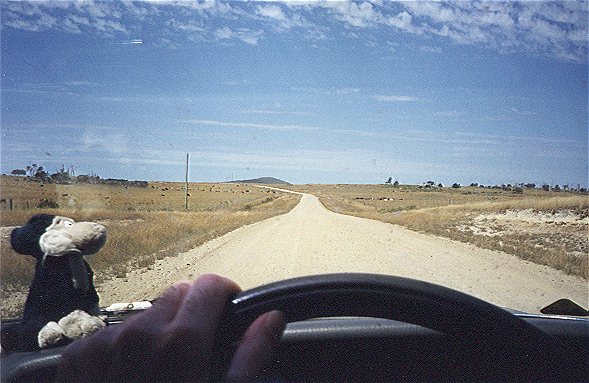
Mt William NP is the stronghold of the Forester Kangaroo (Eastern Grey Kangaroo to anyone lucky enough to get a Yowie version at AAC), but 'roos are crepuscular, and as it was a hot midday I didn't get to see any. I climbed Mt William - more a hill really, but the highest point in this atypically flat part of the state, and got to see some Native Hens (they look a bit like overweight roadrunners. the call of _this_ bird has to be heard to be believed. My friend Ritchie can do an excellent rendition of it. I should tape him some time and put on the web version of this, when I get around to doing it.) |
The camera buggered up here, sorry. |
Afterwards I drove up to a tiny beachside village on the Northeast coast - which, it turns out, is where the St Helens Pelicans had got to. I was standing there on the beach with one of them in the frame of my telephoto lens, thinking it was going to be a rather dull photo, when he decided to take off, giving me what I hope will prove to be a rather good shot. It didn't: the camera buggered up again. It doesn't seem to like being set to 1000th/sec since I dropped it down that cliff the other year.
That night we were relaxing and watching TV (and writing the first half of this), and a story came on, which perhaps you might have caught yourselves. It was from Arkansas or Texas or somewhere in the US. A woman had suffered a heart attack, and been saved by her pot-bellied pig (this was the biggest damn pot-bellied pig I'd ever seen, and I suspected it might have been the result of a South Park-type genetic experiment). The Pig had rushed out to the road-side, and 'played dead', lying with on her back with her legs in the air, until a passing motorist stopped. The motorist ran into the stricken woman's house yelling, according to her, "Ma�am, your pig's in distress! Your pig's in distress!" All I could think was that she was so lucky she lived in Arkansas or wherever, and not in Pynegana, where, of course, the passing motorists would simply have rolled their eyes and said, "Looks like the beer-drinking pig's had a few too many again."
We drove home the next day, and it rained, and washed most of the mud off the car. In two days it's back to work, and I'm glad to have these memories to tide me over till next time.
There's just one thing I wanted to say, in closing. I've been meaning to say it for ages, but never really had an excuse before. It's for anyone who just gets sick of where they live, and I reckon most of us do from time to time. Just do this: when you're driving around, or whatever, imagine you're showing the place to a friend from overseas, or from a long way away: someone who's never seen the place before. You'll see it with new eyes, and the magic that it surely possesses in some measure or some way will be suddenly visible to you again. I do this often, and it really works. I'd like to show it you in RL one day, but in the meantime I can imagine, and it helps me see what's really there. One day a couple of weeks ago I went down to uni in Sandy Bay, to get a few bits of paperwork sorted out. It was a lovely sunny day, and walking back to the car I met a young bloke from Taiwan who was wandering around clutching a Tasmania University prospectus, and looking a bit bewildered. He'd just arrived here on a scholarship, and didn�t know his way around. He was after Sandy Bay Rd, and I took him a few blocks, to point it out to him. Suddenly he exclaimed to me, "Hobart is so beauty!" He's right, and as long as I'm still here, I'll try to see it like he does.